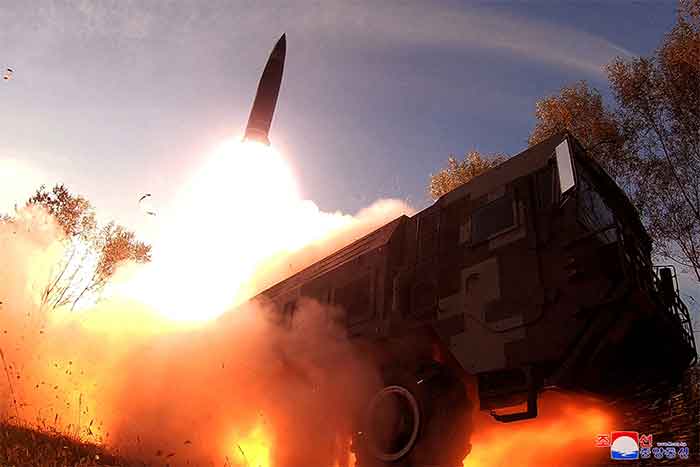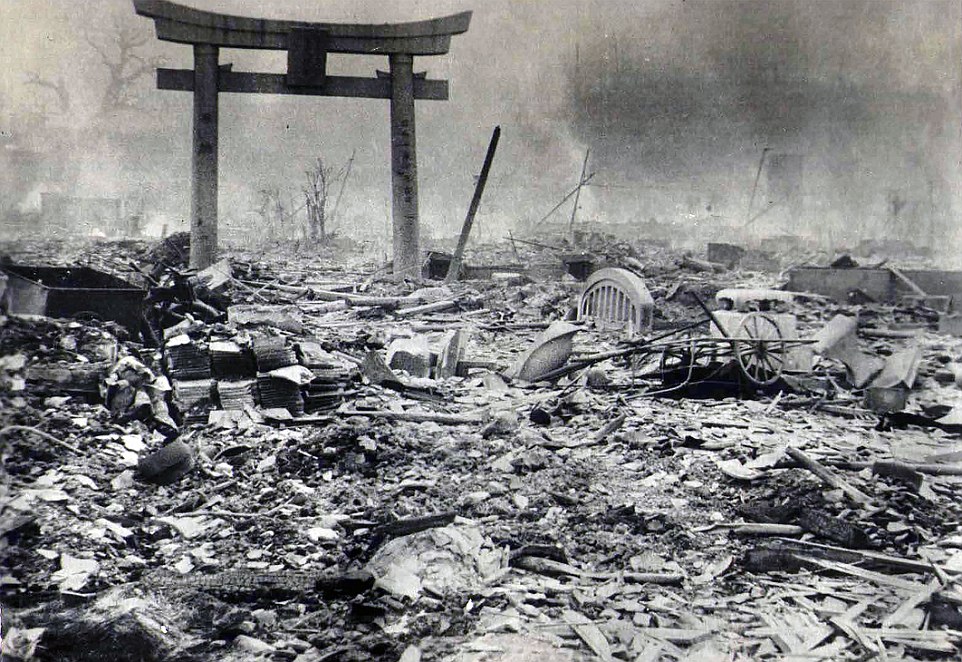Concern over Russia’s potential use of nuclear weapons has been a constant feature of the Ukraine war. But Moscow has several ways to complicate Washington’s global nuclear outlook.

On March 20, 2023, the British government confirmed it would supply Ukrainian forces with tank shells made with depleted uranium, which can “penetrate tanks and armor more easily due to its density and other physical properties.” The affair quickly reignited Western and Russian efforts to shape the global narrative regarding nuclear weaponry in the Ukraine war.
Russian President Vladimir Putin declared that the UK’s decision was part of the collective West’s “nuclear component” against Russia. British Foreign Secretary James Cleverly responded by saying, “The only country in the world that is talking about nuclear issues is Russia.” On March 25, Putin announced that Russia and Belarus had reached an agreement to deploy Russian nuclear weapons on Belarusian territory.
The possibility of a nuclear standoff over Ukraine was not always as likely. By late summer 2022, there was hope that Russia and the U.S. could avoid nuclear brinksmanship. Both countries agreed to begin creating a successor to the New Strategic Arms Reduction Treaty (New START) at the 10th Review Conference for the Treaty on the Non-Proliferation of Nuclear Weapons in August.
But as the Russian military suffered significant defeats around Kharkiv and Kherson in the weeks that followed, this line of thinking declined. Numerous Russian officials, including Putin, began alluding more to the use of nuclear weapons. Putin also stated in late September 2022 that the U.S. had already created the “precedent” of using nuclear weapons in conflict when it dropped nuclear weapons on Japan in World War II.
Russia has, like other nuclear powers, spent billions of dollars upgrading its nuclear weapons program in recent years. The use of hypersonic Russian missiles to deliver a nuclear weapon behind the front lines in Ukraine, or deployment of a “tactical” nuclear weapon, a smaller, low-yield bomb to be used in battle, remains possible. The Kremlin could also conduct nuclear tests as a show of force and to send a message to Ukraine and the West that its threats should be taken seriously.
As Western officials condemned Russia’s nuclear posturing, Putin and other Russian officials in turn suggested that Ukraine might use a “dirty bomb,” an improvised nuclear device that spreads radiation, on its own territory. Western officials believed Russia would use such a false-flag operation to escalate its war efforts.
Speaking to the Russian Federal Assembly in February 2023, Putin announced Russia was suspending participation in the New START deal and would no longer allow the U.S. to inspect its nuclear arsenal. This had already been disrupted due to the COVID-19 pandemic and the war in Ukraine. In 2019, the U.S. meanwhile pulled out of the Intermediate-Range Nuclear Forces Treaty (INF).
Nonetheless, Chinese President Xi Jinping’s comments in November 2022 about avoiding the threat or use of nuclear weapons appeared to have a calming effect on the Russian leadership. And after the battlefield in Ukraine stabilized over the winter and Russia made small advances in the country’s southeast since, the fear of Russia using nuclear weapons declined further.
A Ukrainian attempt to retake Crimea would be the most likely scenario in which Russia would use nuclear weapons. But the Kremlin’s nuclear posturing is likely an attempt to inflame and control the narrative over nuclear weapons in Ukraine. By highlighting the UK’s provision of depleted uranium shells to Ukraine, Russian officials demonstrate to the domestic population the collective military threat emanating from the West. Meanwhile, Russia’s pointing to its own nuclear arsenal reinforces domestic perceptions of Russian strength and its right to employ “strategic deterrence.”
Alluding to the threat of nuclear weapons also forces the West to respond diplomatically. Western officials helped organize an International Atomic Energy Agency (IAEA) visit to Ukraine in November 2022, for example, to ensure Ukraine did not have a dirty bomb and to undermine Russia’s claims. Moscow has also been increasingly resorting to tactics that threaten the safety of Ukraine’s nuclear power plants. On March 29, IAEA Director General Rafael Mariano Grossi made his second visit to Ukraine’s Zaporizhzhia Nuclear Power Plant since the start of the war “to reduce the risk of a major nuclear accident.” Both Russia and Ukraine have accused one another of bombarding the facility since the start of the war.
While the threat of Russian nuclear weapons against Ukraine appears to have receded for now, the U.S. remains concerned over Russia’s ability to help other countries develop their nuclear weapons programs. Russian nuclear scientists (and those from other post-Soviet countries) gave significant assistance to North Korea’s nuclear program in the 1990s, helping it achieve its own nuclear detonation by 2006.
Today, the focus is on Iran, which is increasingly tied to Russia and China. After the collapse of the Joint Comprehensive Plan of Action (JCPOA) deal in 2018, the U.S. no longer has as much leverage over Iran as it did eight years ago when the agreement was first reached. U.S. officials stated in November 2022 that Iran was seeking Russian help to develop its nuclear program if a new nuclear deal did not materialize.
Russia has housed Iranian enriched uranium as part of the JCPOA agreement since 2015, and U.S. foreign intelligence officials in March 2023 are alleged to have said that Putin had agreed to return it if a new nuclear deal collapses. With Russia’s current challenges in Ukraine, Russia also has less leverage over Iran than it did in 2015, and Iran is suspected to have pressed for the return of its enriched uranium in exchange for the weapons it has supplied Russia in recent months.
A nuclear-armed Iran would significantly undermine U.S. interests in the Middle East and would require Washington to divert significant resources to the region, a notion that is obviously tempting in Moscow. But helping Iran gain nuclear weapons would cause a significant downturn in Russian-Israeli relations, leading to a likely destabilizing scenario for the Russian military in Syria. It would also invite the Israeli military and government to drastically increase their support for Ukraine, while spurring a nuclear arms race in the Middle East.
In January 2023, IAEA Director General Grossi stated that Iran has enough highly enriched uranium to build several nuclear weapons. But Iran will likely only move forward with its nuclear weapons program with Russian and Chinese support. For Russia, prolonging negotiations over Iran’s nuclear program is a useful bargaining chip with the U.S. Helping forge a new nuclear deal would also help Russia portray itself as a responsible actor in world affairs after its reputation has been damaged because it invaded Ukraine.
But Washington is also concerned over Russian efforts to aid China’s nuclear program. In December 2022, Russia’s state-owned nuclear power company, Rosatom, began sending nuclear fuel to China’s fast breeder nuclear reactor on Changbiao Island, expected to be functioning by the end of 2023. U.S. military officials fear the reactor, capable of producing weapons-grade plutonium, will be used by China to rapidly increase its nuclear arsenal, as well as to dethrone the U.S. as the world’s top nuclear energy provider by the 2030s.
In addition to the billions of dollars of deals it has around the world, Rosatom is also essential to the U.S. nuclear power industry. Russia accounts for almost half of global uranium enrichment capacity, and the U.S. depends on Russia for both uranium supply and enrichment services. Kazakhstan meanwhile accounts for 35 percent of U.S. uranium supply, and its industry works closely with Rosatom. Several European countries’ nuclear industries also remain reliant on Rosatom, preventing the West from sanctioning the company.
Since Russia invaded Ukraine, the Kremlin has alluded to the use of nuclear weapons in the country and undermined the safety of Ukraine’s nuclear power plants. But growing Russian nuclear collaboration with countries like China and Iran and the reliance of the U.S. and European countries on Rosatom show the multifaceted nuclear threat Russia poses to Western interests. While the risk of nuclear weapons being used by Russia remains low, Moscow has numerous ways to cause nuclear headaches in Washington and Brussels.
John P. Ruehl is an Australian-American journalist living in Washington, D.C. He is a contributing editor to Strategic Policy and a contributor to several other foreign affairs publications. His book, Budget Superpower: How Russia Challenges the West With an Economy Smaller Than Texas’, was published in December 2022.
This article was produced by Globetrotter. J














































